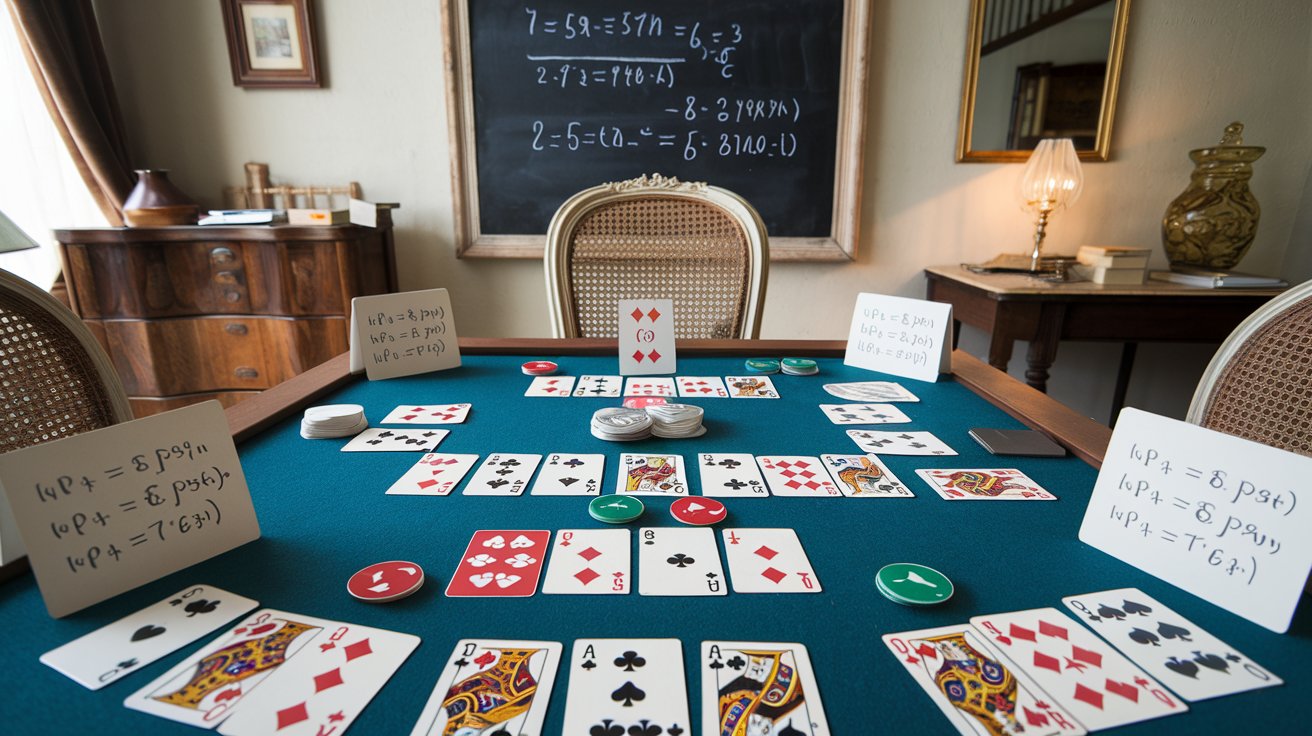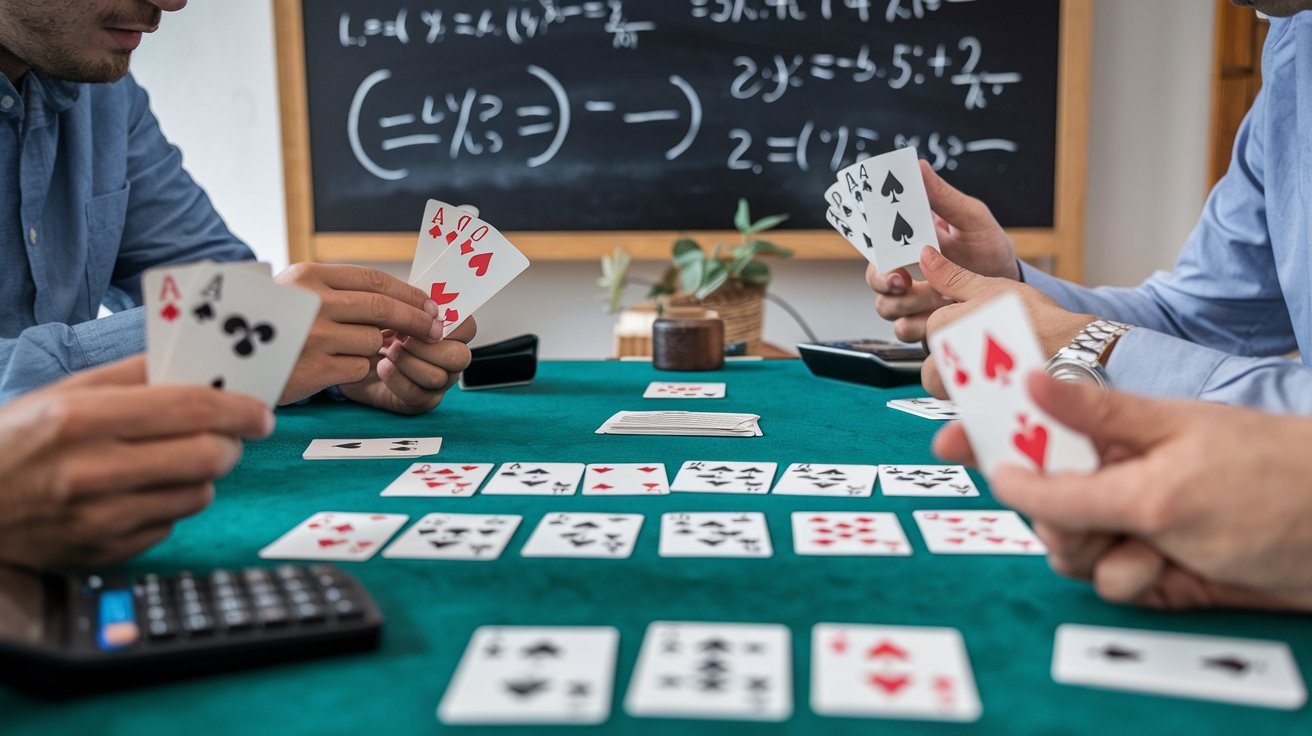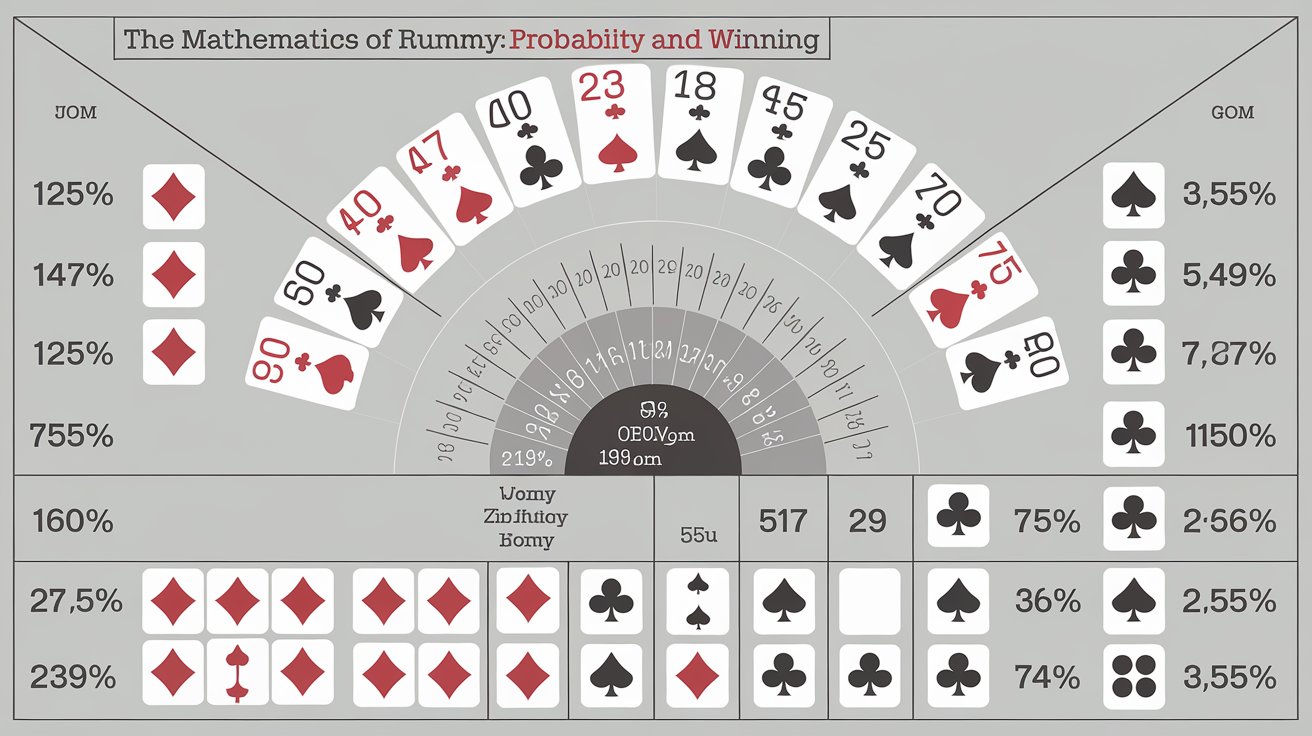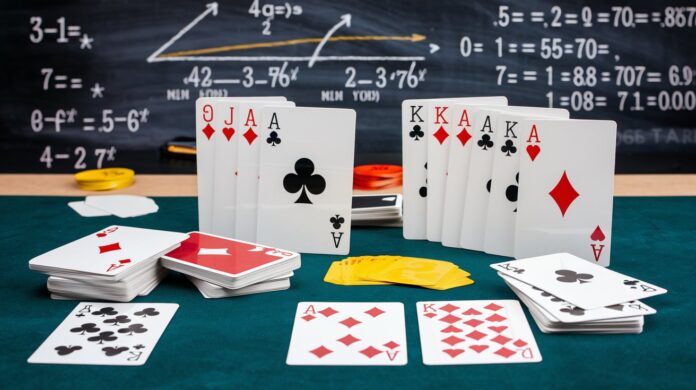When most people think of Rummy, they envision a casual card game enjoyed with friends and family. However, beneath its accessible exterior lies a complex mathematical framework that can dramatically improve your chances of winning. Understanding the probability principles that govern Rummy can transform your play from intuition-based to strategically optimized.
In this comprehensive guide, we’ll explore how mathematics influences every aspect of Rummy gameplay, from initial hand assessment to endgame calculations. Whether you’re a casual player looking to gain an edge or a serious competitor preparing for tournaments, mastering these mathematical concepts will elevate your Rummy performance to new heights.
The Numbers Behind the Cards
Deck Composition and Initial Probabilities
A standard deck contains 52 cards, divided into four suits with 13 ranks each. In traditional Rummy:
- Each rank (Ace through King) appears exactly 4 times in the deck
- Each suit (Hearts, Diamonds, Clubs, Spades) contains exactly 13 cards
- The probability of drawing any specific card is 1/52 (approximately 1.92%)
- The probability of drawing any specific rank is 4/52 (approximately 7.69%)
- The probability of drawing any specific suit is 13/52 (25%)
In games using multiple decks or jokers, these basic probabilities change proportionally. For instance, in a two-deck game:
- The probability of drawing a specific card becomes 2/104 (still approximately 1.92%)
- The probability of drawing a specific rank increases to 8/104 (approximately 7.69%)
- The overall distribution remains the same, but the absolute numbers of available cards double
Initial Hand Probability Assessment
When you receive your initial hand (typically 7-13 cards depending on the variant), mathematical analysis can immediately provide insights:
- Pair Detection: In a 10-card hand from a single deck, the probability of having at least one natural pair is approximately 94%
- Sequence Potential: The probability of being dealt three consecutive cards of the same suit in a 10-card hand is roughly 54%
- Dead Card Analysis: With a 10-card hand, approximately 2-3 cards will typically have minimal melding potential with your existing hand
These baseline probabilities help inform your initial strategy, highlighting which cards have statistical promise versus those that are mathematical liabilities.
Probability Dynamics During Play

Drawing Probabilities and Their Evolution
As the game progresses, probabilities shift substantially:
- Conditional Probability: Each card removed from play changes the probability landscape for remaining cards
- Deck Depletion Effect: As the deck shrinks, probabilities for specific cards fluctuate significantly
- Knowledge Accumulation: Visible discards provide concrete information that refines probability calculations
For example, if you need a 7 of Hearts to complete a sequence:
- Initial probability (if unseen): 4/52 (7.69%) for any 7; 1/52 (1.92%) for the 7 of Hearts
- After seeing two 7s discarded: 2/42 (4.76%) for any remaining 7
- After seeing the 7 of Diamonds, Clubs, and Spades discarded: 1/39 (2.56%) for the 7 of Hearts
- If the deck is down to 20 cards and you haven’t seen the 7 of Hearts: 1/20 (5%)
This dynamic probability assessment should inform every drawing decision you make.
Calculating Draw Expectations
A fundamental question in Rummy is whether to draw from the deck or take the known discard. This decision can be optimized mathematically:
- Expected Value (EV): Calculate the average value of each drawing option
- Opportunity Assessment: Weigh the certainty of the discard against the potential of an unknown card
- Multi-card Consideration: Sometimes drawing from the deck offers the chance to complete multiple potential melds
The mathematical formula for this decision often looks like:
Value(discard) vs. (Probability of useful card from deck × Value of that card)
If the discard would complete a meld worth 3 points, and there’s a 25% chance of drawing a card from the deck that would complete a meld worth 8 points, the expected value comparison would be:
Discard EV: 3 points (100% certain) Deck EV: 2 points (25% × 8 points)
In this case, the discard has higher expected value.
Discard Probability Analysis

When deciding which card to discard, probability calculations are equally crucial:
- Safety Assessment: Calculate the likelihood that your discard will help opponents
- Card Distribution Knowledge: Use observed discards to estimate the probability of a card being useful to others
- Danger Card Identification: Mathematically identify which cards pose the least risk when discarded
For example, if you’ve observed numerous high spades discarded, the remaining high spades become statistically safer to discard since fewer potential spade sequences remain possible for your opponents.
Melding Mathematics
Optimal Melding Strategies
The mathematics of when to meld involves complex decision trees:
- Point Exposure Calculations: Balance the risk of exposing your strategy against the benefit of reducing potential point liability
- Timing Optimization: Use probability to determine whether waiting for a more optimal meld configuration is mathematically justified
- Hand Reduction Value: Calculate how melding affects your drawing odds for remaining cards
Consider a situation where you could meld three 8s now, or wait for a fourth 8 to create a more valuable meld. If the fourth 8 remains unseen, the probability calculation might look like:
Probability of drawing fourth 8 = Remaining 8s ÷ Remaining unseen cards
If there’s 1 remaining 8 and 30 unseen cards, the probability is just 3.33%. If drawing continues for an expected 5 more rounds, the cumulative probability of seeing that 8 is about 16.5% – likely too low to justify waiting.
Set vs. Sequence Optimization
Mathematics can determine whether pursuing sets or sequences offers better expected outcomes:
- Completion Probability: Compare the probabilities of completing potential sets versus sequences
- Card Utility Analysis: Calculate the “utility density” of cards that serve multiple potential melds
- Flexibility Value: Quantify the value of maintaining flexible hand configurations
For example, holding 5-6-7 of hearts and 6-7-8 of clubs creates an interesting mathematical decision. The overlapping 6-7 cards serve double duty, creating a “probability leverage” effect that increases your chances of successful melding compared to holding isolated potential melds.
Endgame Mathematics

Calculating Win Probabilities
As the game nears conclusion, precise mathematical calculations become even more critical:
- Card Distribution Mapping: Using all visible information, construct probability maps of remaining unseen cards
- Draw-to-Win Calculations: Determine the exact probability of drawing the specific cards needed to win
- Opponent Hand Estimation: Statistically model the likely compositions of opponent hands
For example, if you need exactly one specific card to win, and there are 15 cards remaining with 2 opponents holding 6 cards each, the probability calculation becomes:
Probability the card is still available = 1 – (Probability it’s in opponent hands) = 1 – (6/15 + 6/14) = approximately 16.2%
Optimal Stopping Problems
One of the most challenging mathematical aspects of Rummy is determining when to “knock” or declare in variants that allow this:
- Expected Value Comparison: Calculate the EV of declaring now versus playing additional rounds
- Risk Assessment: Quantify the risk of opponents going out while you seek better hand configuration
- Point Differential Analysis: Optimize decisions based on the mathematical expectation of point differentials
This represents a classic “optimal stopping problem” in mathematics, where the decision to continue or stop must balance immediate reward against future potential.
Advanced Mathematical Concepts in Rummy
Card Counting and Memory Systems
Elite Rummy players employ sophisticated card counting systems:
- Categorical Counting: Track card groups rather than individual cards to reduce cognitive load
- Priority Tracking: Focus counting efforts on cards most relevant to your hand
- Bayesian Updates: Continuously refine probability estimates as new information emerges
Effective card counting allows you to calculate precise probabilities in real-time, transforming educated guesses into mathematical certainties.
Game Theory Applications
Rummy represents a complex game theory environment:
- Mixed Strategy Equilibria: Identify optimal randomization strategies for drawing and discarding
- Opponent Modeling: Use statistical patterns to create mathematical models of opponent tendencies
- Sequential Game Analysis: Apply backward induction to optimize decision trees
Understanding these game theory concepts allows you to make decisions that are not just probabilistically sound but strategically optimal against thinking opponents.
Mathematical Psychological Warfare
The intersection of mathematics and psychology creates powerful winning opportunities:
- Pattern Establishment and Breaking: Create mathematical patterns in your play, then strategically break them to exploit opponent adaptations
- Information Theory Application: Control the information revealed by your plays to maximize uncertainty for opponents
- Baiting Calculations: Determine when the expected value of a deceptive play exceeds that of straightforward optimal play
By quantifying psychological elements, you can incorporate them into your broader mathematical strategy.
Practical Implementation: From Theory to Practice
Mental Math Shortcuts for Real-Time Play
While the mathematics of Rummy is complex, practical application requires efficient mental calculation:
- Denominator Simplification: Focus on fractions with easily managed denominators
- Probability Ranges: Work with approximate probability ranges rather than exact percentages
- Rule of Thumb Heuristics: Develop personal mathematical shortcuts based on common scenarios
For example, rather than calculating that the probability of drawing any specific card from 20 remaining cards is 1/20 (5%), simply remember that each card has “one chance in cards remaining.”
Statistical Record Keeping
Serious players track their play statistically:
- Decision Outcome Tracking: Record the results of key mathematical decisions to refine future calculations
- Probability Verification: Check actual outcomes against theoretical probabilities to identify areas for improvement
- Pattern Recognition Development: Use statistical records to identify recurring patterns that might not be immediately apparent
This empirical approach helps bridge the gap between theoretical mathematics and practical application.
Probability-Based Training Regimens
Improve your mathematical Rummy skills through targeted practice:
- Probability Estimation Exercises: Practice quickly estimating probabilities in isolated scenarios
- Decision Tree Mapping: Regularly work through complete decision trees for complex situations
- Post-Game Mathematical Analysis: After playing, analyze key decisions from a purely mathematical perspective
These focused exercises build the mathematical intuition necessary for high-level play.
Conclusion: The Mathematical Mindset
Approaching Rummy with a mathematical mindset transforms the game from a casual pastime to a fascinating exercise in applied probability. While natural card sense and intuition certainly have their place, players who complement these qualities with solid mathematical understanding gain a significant competitive advantage.
Remember that mathematical optimization in Rummy isn’t about performing complex calculations for every decision—it’s about understanding the probabilistic framework that governs the game and developing intuition that aligns with mathematical reality. Over time, many of these calculations become second nature, allowing you to make mathematically sound decisions almost instinctively.
Whether you’re playing for fun with friends or competing in high-stakes tournaments, the mathematics of Rummy provides a powerful lens through which to view and improve your game. By incorporating these probability concepts into your play, you’ll make better decisions, reduce the impact of bad luck, and ultimately win more consistently.
So the next time you sit down for a game of Rummy, remember that behind the casual shuffling and dealing lies a rich mathematical landscape waiting to be explored and exploited. Your opponents may be playing cards—but you’ll be playing the numbers.

Zareb Saleh is a journalist at Gulf Today and a ghostwriter for Gameoholic, specializing in gaming, technology, and digital culture. With a keen eye for industry trends, he delivers insightful stories that engage and inform readers.




